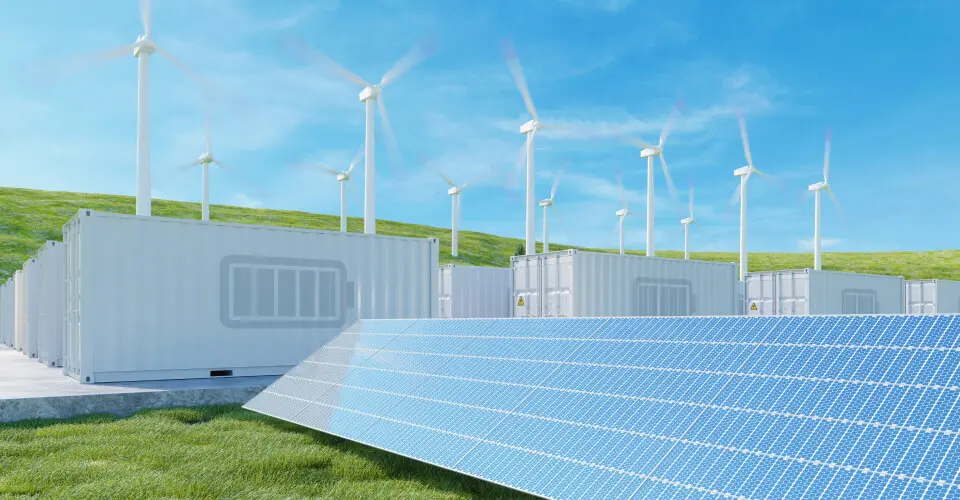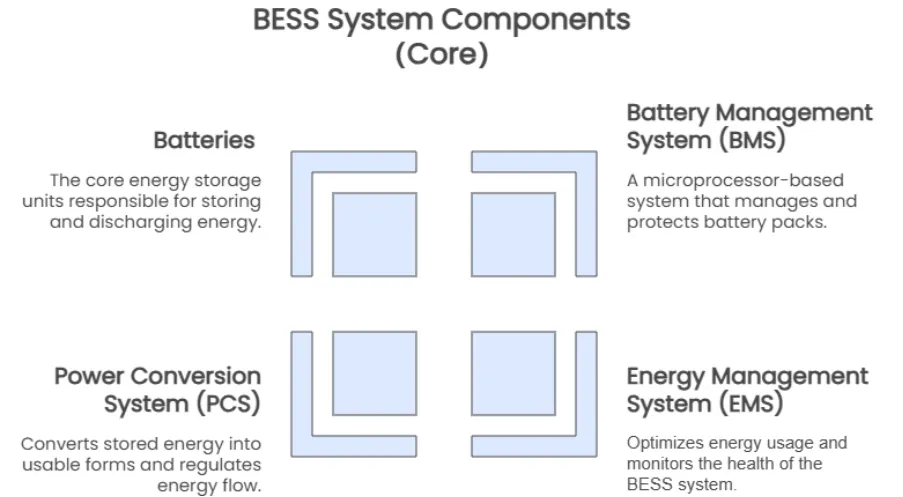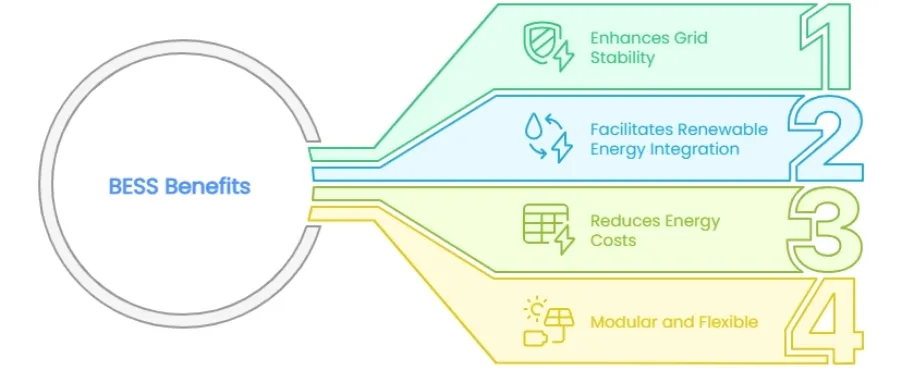Battery storage is an important part of a steady supply of energy. The technology of the battery energy storage system (BESS) uses a group of batteries that store electrical energy in the grid. It captures energy from both renewable and nonrenewable energy sources to store in rechargeable batteries. This system is designed to output for several hours nonstop at full-rated power.
In recent years, we have seen a huge spike in the use of renewable energy sources. This increase and the goal to reach net zero carbon emissions make the BESS system an important technology for industrial and commercial organizations. Let’s understand how the BESS system works and what its core components, main applications, and benefits are.

How Does the BESS System Work?
A BESS has a simple operating principle. It revolves around energy storage and controlled discharge. BESS collects energy through either of the two sources:
- The power grid, or from
- Renewable sources like solar panels or wind
It then stores this energy and releases it when needed, such as during:
- Power outages
- Peak demands
- Grid balancing
- Unavailable periods of renewable sources
BESS can be combined with software (AI, Machine Learning, and data-driven solutions) to make its use more streamlined, structured, and flexible.
Core Components of the BESS System
A well-designed BESS system consists of several integral components. The components may vary depending upon the types of battery energy storage systems. These core components work harmoniously and deliver effective energy storage solutions. Let’s have a look at the conventional components:

1. Batteries
A battery is the heart of the BESS system. This is the core unit that is responsible for storing energy and discharging it according to the need. In commercial settings, batteries are designed to handle heavy energy loads. There are several types of batteries used depending on the specific applications:
- Lithium iron phosphate batteries
- Flow batteries
- Lead acid batteries
These are the most used types of batteries for commercial and large-scale BESS applications.
2. Battery Management System (BMS)
It is a microprocessor-based system that manages and protects the battery packs in the BESS system. It has the following functions:
- Real-time monitoring of the key parameters like current, voltage, and temperatures of the cells.
- Balancing and equalization to maintain uniformity and prevent degradation of capacity.
- Provides protection mechanisms to avoid over current, overcharge, over-discharge, and thermal management.
- Records the operational data of the BESS system and communicates with other systems.
- Prolongs the life of the battery by accurately managing charging and discharging cycles.
3. Power Conversion System (PCS)
This vital component of the BESS system controls energy flow between the grid and the battery. It converts stored forms of energy into usable form. In other words, PCS converts DC (Direct Current) into AC (Alternating Current). Moreover, it also provides some power management features like:
- Voltage and frequency regulation
- Safety and protection mechanisms
- Harmonics controls
4. Energy Management System (EMS)
It acts as the brain of the BESS system. It has the following critical functions:
- EMS can optimize energy usage through data collection and analysis. Operators or decision makers can decide when to charge and discharge the battery by considering factors like energy prices, energy demands, and grid conditions.
- EMS can automate demand response management in which the utility pays the business to decrease the use of energy during peak hours.
- It regularly monitors the status and health of the entire BESS system.
Main Applications of the BESS System
The BESS system is an important part of the modern energy infrastructures. It is used in many scenarios, from homes to large-scale industrial settings.

- Utility-scale Energy Storage: BESS utility solutions support large-scale renewable energy integration. It stabilizes the grid and provides a reliable power supply.
- Commercial and Industrial Energy Storage: The BESS system provides many benefits to this sector through improved energy reliability, energy cost management, and demand charge reduction. Large-scale settings have a huge impact on supporting sustainability. BESS helps to achieve these goals by enabling the use of renewable energy at a greater level.
- Residential Energy Storage: Smart BESS battery energy storage systems like Tesla’s Powerwall allow residents to store energy created by solar panels on rooftops. This energy can be used during the night or during power outages.
- UPS Energy Storage: Uninterruptible power supply (UPS) provides immediate backup power to critical infrastructure and prevents disruptions during power failures. It plays a vital role in data centers, hospitals, and other facilities where continuous power is essential.
- Microgrid and Island Grid Energy Storage: In remote or island communities, BESS provides energy independence without relying on mainland grids or imported fuels.
Advantages of the BESS System

BESS provides numerous benefits, such as:
- Enhances Grid Stability: BESS provides frequency regulation and voltage support. It helps maintain grid reliability and prevents power outages, especially in areas with high penetration of intermittent renewable energy sources.
- Facilitates Renewable Energy Integration: BESS stores surplus energy produced by renewable sources. It allows for its use during periods of low generation. This way it smoothes out fluctuations in renewable energy production.
- Reduces Energy Costs: Through peak shaving and load shifting, BESS minimizes energy expenses. It reduces demand charges and takes advantage of lower electricity rates during off-peak periods.
- Modular and Flexible: BESS installations can be scaled to meet various energy needs. We can use them from small residential systems to large utility-scale projects. They provide flexibility in deployment and capacity expansion.
REPT BATTERO – Your Trusted Partner in BESS System Solutions
REPT BATTERO is known for achieving outstanding results in the energy storage market. Our smart energy storage solutions have been loved for years in most parts of the world. This is because from large-scale utility projects and commercial energy storage to residential applications, our solutions are designed to meet diverse energy demands.
In 2024, REPT BATTERO ranked fifth globally in energy storage battery cell shipments and second in household storage battery shipments. Additionally, REPT BATTERO has been recognized as a “Bloomberg New Energy Finance Tier 1 Energy Storage Supplier” for five consecutive quarters.
The challenges in energy supply-demand balance and the urgent need for renewable energy integration are increasing every day. That’s why we cannot overstate the significance of a robust BESS system. Get to know REPT BATTERO and learn how our battery storage solutions can transform your energy management strategy.





